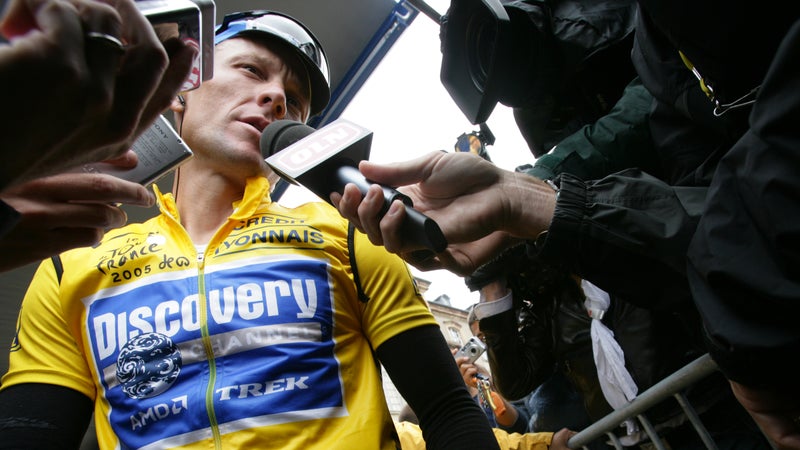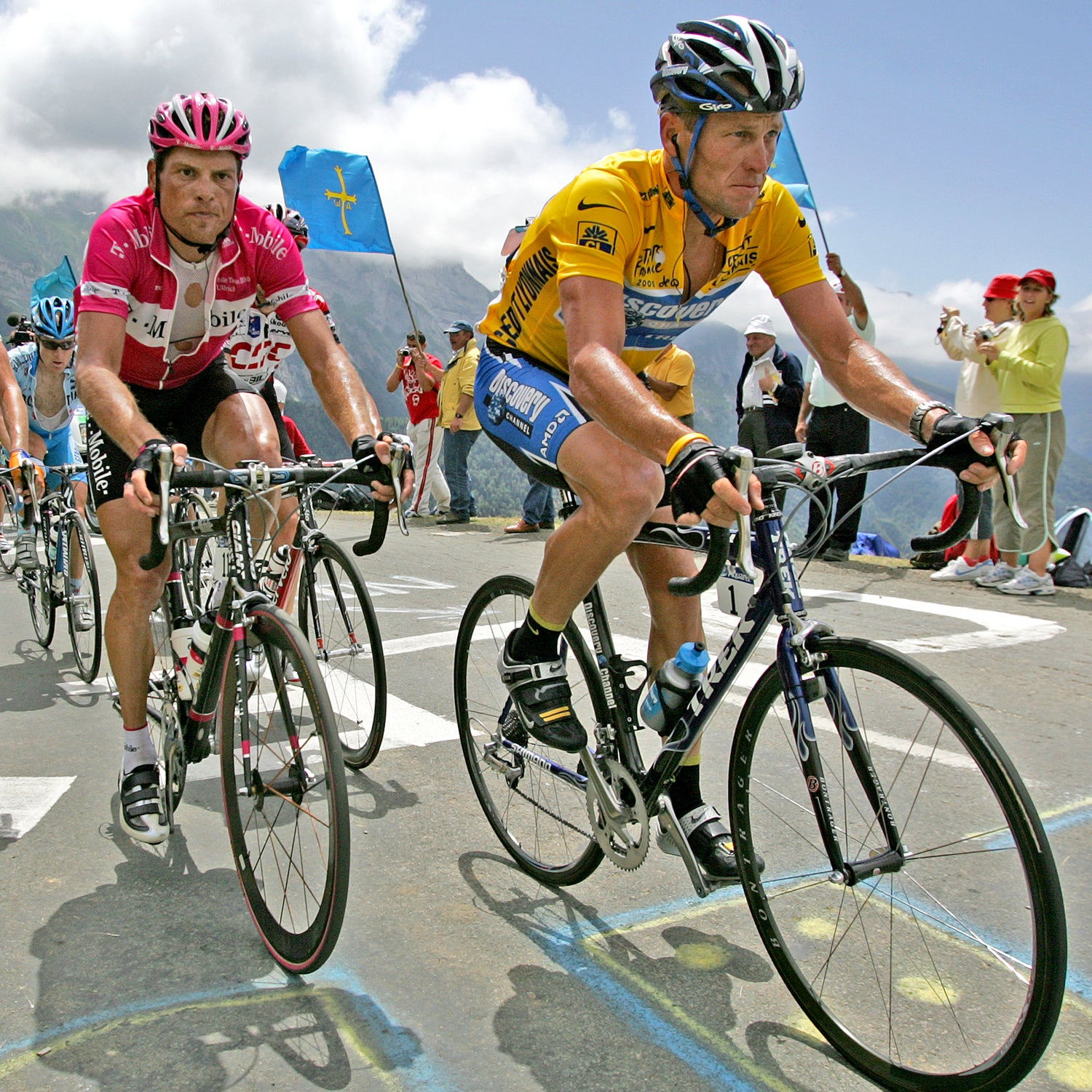Why now?
Judging by the chatter on cycling Twitter, that was the most common reaction to ESPN’s announcement earlier this month that it would be premiering Lance, a new big-budget, two-part 30 for 30 documentary on the rise and fall of the world’s most infamous bike racer, on May 24.
It’s a fair question. After all, we’re now seven years removed from Lance Armstrong giving his first doping confessions to Oprah. That same year saw the release of The Armstrong Lie, a full-length documentary by an Oscar-winning director that, just like this one, includes Armstrong’s lengthy admissions of guilt and claims of sincere remorse. Since then his reputation has suffered death by a thousand memoirs, with nearly anyone with the slightest connection to the cyclist publishing their own tell-all, while Armstrong himself has launched multiple apology tours to demonstrate his contrition and control the damage. Whatever hunger there once was to reexamine this saga would seem to have been sated. The carcass has been picked clean. So why now?
The most cynical answer, of course, is ratings. We’ve all endured two months without the distraction of live sports, a cruel fact that has left the world’s biggest sports network with gobs of airtime to fill and nothing new to discuss. Aside from the NFL draft, the network’s lone bright spot has been The Last Dance, the ten-part Michael Jordan documentary that has garnered record ratings. The docuseries gave ESPN some elusive momentum, but the final episode aired on May 17, and Lance wasn’t originally scheduled to premiere until the fall. If you want to best understand why it rushed the broadcast debut to this weekend, picture a bunch of executives in Bristol, Connecticut, turning their baseball caps inside out and trying to keep a rally going.
https://youtube.com/watch?v=YUsakV8RzZo
For a more philosophical explanation as to why Lance exists, we can turn to director Marina Zenovich, who spent 18 months on the project. Zenovich is a big deal in the documentary world, having spent her career churning out portraits of complicated men, including Roman Polanski, Robin Williams, and the Duke lacrosse team. One could argue that her skills as a filmmaker are enough on their own to justify the project—few people challenge the Coen Brothers’ right to revisit Scarface—but she’s hardly been immune from the same line of questioning. Back in January, when Lance premiered at the Sundance Film Festival, Zenovich sat for an interview with TheWrap. First question: Why now?
“A lot of time has passed,” she answered. “And I think he was willing to come forward and tell his story. I think. I mean, I tried.” She laughed at that point, realizing that any discussion of Lance telling the truth was fraught. A few minutes later she zeroed in on what is perhaps the whole point of this project. “What I found really interesting is that Lance has processed a lot of what he’s gone through,” she said, “and has come out the other side—for himself. Other people haven’t. And then you get into scorekeeping—Well, has he processed enough?”
And there you have it, the question we—and Lance—can’t stop wrestling with. We all know he cheated, got caught, and said he was sorry. But how do we break down his sorry into discrete units that can be measured on a public-forgiveness scale? Is he sorry enough that we should reevaluate his seven Tour de France victories, stop overlooking his inspiring work as an advocate for cancer patients, and let him back into our lives? Those questions are at the heart of Lance and perhaps provide the only sound rationale for tuning in. If there’s truly been a battle raging these last seven years between Old Lance (defiant, petty, destructive, lying) and New Lance (woke, introspective, apologetic, transparent), let’s check in and see if we can figure out who’s winning.
Part one of Lance sets the table for this analysis. During a very entertaining hour and a half, Zenovich retells the story of Armstrong’s meandering ascent up Alpe d’Fame. We examine his humble beginnings as the son of a teen mom in Plano, Texas; witness the discovery of his prodigious talent when he was introduced to swimming and triathlon as a teenager; and watch him eventually commit to cycling and use his raw abilities to become an unexpected world champion in 1993.
Early on in the episode, Armstrong promises Zenovich, “I’m not going to lie to you, Marina. I’m going tell you my truth,” but thankfully, his recollections of this era aren’t the only ones we have to rely on. Zenovich seems to have tracked down everybody for this project—coaches, teammates, friends, enemies. The list of surprising talking heads includes Armstrong’s estranged stepfather, who at one point tries to justify his tough love and physical punishment by arguing that teenage Lance wouldn’t have become such a fierce competitor without him. (Let’s just say that adult Lance doesn’t agree.)

Most viewers will be familiar with this material, but the pacing is stellar. And if nothing else, it’s still interesting to reexamine his rise, this time with none of the players weighed down by the pretense that Armstong was doing it all without performance-enhancing drugs (PEDs). Equally fascinating are all the old interview clips researchers dug up. Some of the Armstrong interview footage will be new to anyone who, like me, didn’t follow cycling between the era of Greg LeMond (who won the Tour de France a third and final time in 1990) and Armstrong’s first Tour victory in 1999. Watching a twentysomething Armstrong present himself to the world back then is cringeworthy. I don’t want to spoil anything, but boy, was he a dick.
Whatever you think of the man now, however, the cancer part of his backstory is still moving. We see Armstrong close to death, robbed of all his physical gifts, and humiliated as he tries to find a new team willing to invest in his comeback once he’s in remission. Part one ends with Armstrong’s first Tour win, reminding us why we were all so captivated by his story in the first place. We’re also reminded of how quickly he had to transition, literally overnight, from being virtually unknown to Wheaties-box famous. Consider that in July of 1999, Armstrong’s public profile largely consisted of a modest website for his recently created cancer foundation, housed on a few rickety servers in a friend’s garage. The day he stood atop the podium in Paris, all those servers crashed.
Things get a lot more interesting in part two, which airs May 31, beginning with Zenovich casually lobbing the following from behind the camera: “Do you feel like you want to be relevant again?” All we see is Armstrong, who seems to flinch for a second from the audacity of such a question. “This is gonna sound terrible,” he answers, “but I am relevant. I am.” The exchange may explain Armstrong’s participation in this project and why he’d willingly submit to hours of rigorous on-camera interrogation: He knows his previous efforts have failed. He’s done his time and doesn’t want to be an outcast anymore.
From there we return to the backstory, but the narrative gets bogged down. There are simply too many feuds and scandals to catalog and too little time to assess their impact on either Lance or his many adversaries, beyond listing the surface-level details of his transgressions. Fortunately, Zenovich’s interviews with Armstrong in part two contain enough drama to keep you watching. As anyone who covered him in his prime will tell you, his ability to intimidate journalists and don his “cancer shield” to diffuse tough questions made deep probing of the athlete’s psyche all but impossible at the time. In Zenovich, Armstrong has met his match. She seems unfazed by his legendary staredown and expertly sits through awkward pauses to force him into filling dead air. And on three occasions, she gets the goods.
There are simply too many feuds and scandals to catalog and too little time to assess their impact on either Lance or his many adversaries, beyond listing the surface-level details of his transgressions.
The first happens after a scene filmed at Rice University, where Armstrong’s oldest son, Luke, plays Division I football. After we see Lance give a pep talk to the team, it cuts to him during one of his many sit-downs with Zenovich. She asks what he would tell Luke if he ever wanted to try PEDs himself. “I would say, ‘That’s a bad idea. You’re a freshman in college, that’s… it might be a different conversation if you were in the NFL, but at this point in your career, not worth it.’” So, no to doping now, son, but if you make it to the pros, all bets are off? Fumble!
A few minutes later, the topic turns to Floyd Landis, a former teammate who became the key witness in the government’s whistleblower case, which initially aimed to claw back some $100 million including sponsorship money that the U.S Postal Service hemorrhaged after the widespread news of Armstrong’s doping. This lawsuit once threatened to erase Armstrong’s fortune, but it was settled for $5 million in 2018. One understands why Armstrong and Landis will never be best buds after all that, but the film does a nice job of explaining how Armstrong put Landis in the position of ratting him out in the first place. Still, even though Lance has apologized and tried to make good with many of his other adversaries, it seems that well has run dry. After the film recounts all the money Armstrong lost in canceled endorsement contracts and lawsuits, it cuts to another sit-down.
Armstrong, gesturing to his palatial home in Aspen, Colorado: It could be worse. I could be Floyd Landis.
Zenovich: What, living in Leadville?
Armstrong: Waking up a piece of shit every day.
Zenovich: Is that what you think?
Armstrong: Yeah. That’s what I know.
Sorry, not sorry!
And then there’s the film’s penultimate exchange, the one certain to supply life-giving fodder to all of the sports-starved hosts working in ESPN’s hot-take industrial complex. The scene comes nearly four hours into this saga and clocks in at only four minutes, but it somehow salvages the entire project. It would be criminal to spoil it here. What I can say is that New Lance gets choked up, seemingly out of nowhere, and for 30 agonizing seconds tries to fight back sobs. Then he composes himself, a switch is flipped, and Old Lance is back. At that point, he delivers an extended, defiant monologue that adds up to his most compelling case yet for our collective forgiveness.
Should we buy it? I’ve watched the scene four times, and I honestly have no idea.

